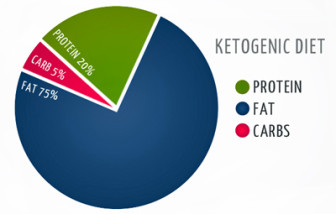[ad_1]
Intro to Keto
by Tony DiCostanzo Health Coach / Keto Transformation Specialist
Imagine… Imagine being able to condition your body to burn only fat for energy. Would that excite you? I’m sure to most it would sound pretty amazing. We all want to get rid of that excess fat in those hard to lose areas—love handles and lower abdomen (pooch)—just to name a couple.
Well, what if I told you that you don’t need to imagine any longer because it’s already possible? That’s right, it is! There is a way to create a metabolic environment in your body, where fat becomes its preferred source of fuel. Enter the ketogenic diet.
A Brief History
As of late, there has been a lot of hype surrounding the keto lifestyle. However, make no mistakes about it, keto goes all the way back to the 1920s. It was way back then when Dr. Russell Wilder and some of his colleagues at the Mayo Clinic began experimenting with what he called the “ketogenic diet” in an effort to help children with epilepsy.
What they discovered was not only did the diet help to
control epileptic seizures, but the children were also thinking and behaving
better, as well. It was the direct
effect of the “ketones” produced in the fastest state which they attributed as
being the cause for the benefits of the diet on epilepsy. What was next was to stimulate the body to
create these ketone bodies without total starvation. They accomplished this “state of ketosis” by
restricting carbs and increasing fat intake.
The “state of ketosis” is when your body is breaking down fat for energy
to produce ketones.
Carbs Are Not Your Friend
Keep in mind, it is the absence of carbohydrates and sugar
that brings your body into a state of ketosis—not simply the addition of a higher
fat diet. You must restrict your carbs in
order to force your body to look for other fuels to burn. If your body doesn’t
have readily available glucose produced from carbs and sugar, it then begins to
burn fat for energy. This also means
that if glucose is present, your body will stop using fat. That’s why on a ketogenic diet you want to
restrict your carbs as much as possible.
Hence, the ketogenic diet, is a high fat, moderate protein,
low carb diet that forces the body to burn fat for fuel. So now, rather than your body using stored
glycogen from carbohydrates, it must break down fat instead. Where will it get that fat from? Well, it will either come from the fat you
eat or the fat you wear on your body. Stay
with me here, because this is why so many on the ketogenic diet can get stuck in
their weight loss efforts. We will come
back to this in a little bit.

https://totalshape.com/
It’s Not Just Fat Loss
First, I think it’s important to point out the many benefits
of ketosis and the keto diet beyond just the fat loss.
- Increased Mental Sharpness and Clarity
- Reduced Appetite and Cravings
- Lower blood Sugar and Insulin Levels
- Weight loss
- Abundant Energy
- Improved Mitochondrial Health
- Better Sleep
- Body Reshaping
- Decreased Inflammation
- Less Anxiety and Depression
- Combat Cancer and Chronic Disease
As you can see, it goes far beyond just weight loss. Personally, I have been utilizing a ketogenic approach to eating for many years now and I believe it to be one of the healthiest and most sustainable diets out there, if done correctly. When just starting out on the keto diet, it’s important to keep in mind that your macronutrients (fats, proteins and carbs) will always need to be shifted to reflect your body’s changes in weight and composition.
Mind Your Macros
For instance, inductively, a typical ketogenic diet may
require the following ratio of macronutrients: 60-70% of calories from fat,
20-30% from protein and 5-10% of calories from carbs. While your carbs will not move much, your
protein and/or fat intake must be adjusted to meet your current needs and goals
as your body is changing.

This takes us back to what I stated earlier. Quite often those who are new to the keto
lifestyle jump out of the gate eating way too much fat for their caloric
requirements. Yet, since they restricted
carbs, initially they’ll see a big drop in weight and so they continue down the
same path without changing a thing.
Unfortunately, the weight loss at the beginning was also a
lot of unwanted water weight. For every
single gram of carb ingested, your body can hold on to 3-4 grams of water. If you do the math, you’ll see just why
cutting carbs can drastically reduce water retention. Yet, that weight loss does not continue. Why?
Because if your body is constantly busy burning off the fat you eat, how
can it burn off the unwanted body fat you so desperately want to lose?
If you’re new to keto, be sure to keep track of your
macronutrients, calories and don’t fear increasing your protein to fat
ratios—particularly if your goal is to get leaner. Remember, based on your body’s needs, you can
always bring those fats up again. As a
coach and trainer, the biggest mistake I see new keto clients making is
overdoing their fats and calories and undereating their protein.
The other issue that can arise on the ketogenic diet is the
overindulging of foods like processed cold cut meats, bacon, butter, sugar
alcohols and nuts. All of these things
have their place in the keto lifestyle, but they should not and cannot be
abused. What happens is that you not
only find yourself eating too many calories in fat and protein, but also
impacting your blood sugar and insulin levels negatively. The next thing that happens is your fat loss
comes to a halt.
So, What Can I Eat?
Assuming that you will try to keep your macronutrients and
calories in check, let’s look at what you should be eating:
- Meats and Eggs (Chicken, Beef, Fish, Pork, lamb, etc.). if you use fattier cuts of meat, cut your fat intake elsewhere. However, I recommend leaner cuts of meat. This allows you to use your fat calories elsewhere on healthy fats like oils, nuts and butters)
- Greens– Arugula, Collard Greens, Romaine Lettuce, Asparagus, brussels Sprouts, Kale. Virtually all leafy greens and above ground vegetables are fine in moderation and if in line with your daily macros.
- Healthy Fats and Oils– Avocados, Macadamia Nut oil, Extra Virgin Olive Oil. Avocado Oil, MCT oil and Coconut oil.
- High-Fat Dairy– Cheese, Cream, Butter, etc. Be careful with overdoing dairy. Many will find that it stalls their weight loss.. Try not to abuse.
- Nuts and Seeds– Pecans, Macadamia Nuts, Almonds, Walnuts and Brazil Nuts.
- Berries– Blueberries, Raspberries, Strawberries and Blackberries (in moderation)
You want to stay away from sugar and sugary foods, grains (rice, pasta, wheat), root veggies like potatoes, starches, fruits, beans and legumes, alcohol, most condiments (hot sauce and mayo are okay in moderation).
You should avoid most artificial sweeteners and “net carb”
products, at least until your body enters a state of ketosis. Then, if possible, you would want to utilize
the natural sweeteners with the least impact on blood sugar (Stevia and Monk
Fruit).
The Final Recap
Now that you know what the Ketogenic diet is, let’s do a
quick overview on how to get started and get your body into a fat burning state
of ketosis in the fastest amount of time.
- Restrict
all carbohydrates to under 30 grams daily.
Get carbs from greens and nuts and seeds. It’s the absence of sugar and carbs that
keeps your blood sugar and insulin levels low.
This allows your body to release fat more freely. - Utilize
fasting to help deplete your body of its stored glycogen. We need to get all of
the glycogen out of your system so that we can get into a state of ketosis and
burn that body fat. If fasting and going
without food is too difficult, try skipping a meal or two. - Exercise
and move your body. Full body workouts
will deplete the body of glycogen faster than any other type of workout. Focus on major body parts like legs, back and
chest and move through the workout quickly with little rest between sets and
movements. - Drink
lots of water and be sure to supplement with minerals and electrolytes.
As your body is shifting fuel sources and acclimating from
glucose to a ketogenic state, you may feel lightheaded, dizzy, experience
weakness and fatigue. It’s important to
remember, you’re not only transitioning your body to a different metabolic mode
of energy management, but you’re also detoxing your body from sugar, processed
foods and unhealthy carbs.
In the long run, this will all lead to a leaner, healthier and much more vibrant you!


Tony has been a health coach for many years, specializing in Ketogenic transformations. He provides a straight-forward approach to diet and nutrition with proven successes among all of his clients. His favorite True Nutrition products include our Grass-Fed Beef Protein Isolate and Egg White Protein. Hungry for more information? Be sure to follow Tony on Instagram: @ketoshreds!
The post Intro to Keto appeared first on True Nutrition Community.
[ad_2]
Source link







